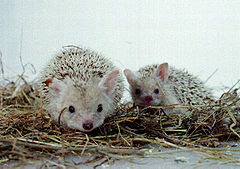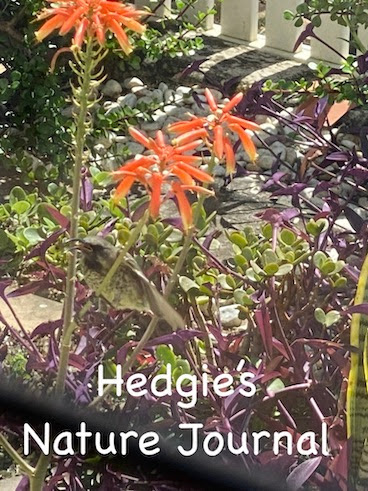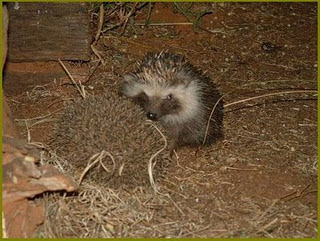Physical description
Hedgehogs are easily recognized by their spines, which are hollow hairs made stiff with keratin. Their spines are not poisonous or barbed and, unlike the quills of a porcupine, cannot easily be removed from the animal. However, spines normally come out when a hedgehog sheds baby spines and replaces them with adult spines. This is called "quilling". When under extreme stress or during sickness, a hedgehog can also lose spines.
 Hedgehog spine, magnification 20 x
Hedgehog spine, magnification 20 x
 Hedgehog spine, magnification 200 x
Hedgehog spine, magnification 200 x
A defence that all species of hedgehogs possess is the ability to roll into a tight ball, causing all of the spines to point outwards. However, its effectiveness depends on the number of spines, and since some of the desert hedgehogs evolved to carry less weight, they are much more likely to try to run away and sometimes even attack the intruder, trying to ram into the intruder with its spines, leaving rolling as a last resort. This results in a different number of predators for different species: while forest hedgehogs have relatively few, primarily birds (especially owls) and ferrets, smaller species like the Long-eared hedgehog are preyed on by foxes, wolves and mongooses.
All hedgehogs are primarily nocturnal, although different species can be more or less likely to come out in the daytime. The hedgehog sleeps for a large portion of the daytime either under cover of bush, grass, rock or in a hole in the ground. Again, different species can have slightly different habits, but in general hedgehogs dig out dens for shelter. All wild hedgehogs can hibernate, although not all do; hibernation depends on temperature, species, and abundance of food.
Hedgehogs are fairly vocal, and communicate not only in a series of grunts and snuffles, but sometimes in loud squeals (depending on species).
Hedgehogs occasionally perform a ritual called anointing. When the animal comes across a new scent, it will lick and bite the source and then form a scented froth in its mouth and paste it on its spines with its tongue. It is not known what the specific purpose of this ritual is, but some experts believe anointing camouflages the hedgehog with the new scent of the area and provides a possible poison or source of infection to any predator that gets poked by their spines. Anointing is sometimes also called anting because of a similar behaviour in birds.
Similar to opossums, mice, and moles, hedgehogs have some natural immunity against snake venom due to the protein erinacin in the animal's muscular system.
Hedgehogs perform well with other pets, including cats and dogs. They are occasionally threatened by these animals, though, but for those rare instances, the hedgehogs just roll into a ball until the threat is gone.
Diet
 A West European Hedgehog
A West European Hedgehog
Although traditionally classified in the now abandoned order Insectivora, hedgehogs are not exclusively insectivores, but are almost omnivorous. Hedgehogs feed on insects, snails, frogs and toads, snakes, bird eggs, carrion, mushrooms, grass roots, berries, melons, and watermelons. In fact, berries constitute a major part of an Afghan Hedgehog's diet in early spring after hibernation. The hedgehog is occasionally spotted after a rainstorm foraging for earthworms. Although forest hedgehogs, most well-known to Europeans, are indeed mainly insectivores, this is not necessarily true for other species.
In areas that have hedgehogs in the wild, they are often welcomed as a natural form of garden pest control. Many people leave food out to attract hedgehogs. Although hedgehogs are lactose-intolerant, they will eagerly consume cheese, milk, and dairy products, causing illness. The common pet hedgehog (Four-toed Hedgehog) can however have a small portion of cottage cheese as a dietary supplement. Dog and cat food are better than dairy, but both are often too high in fat and too low in protein. It is best to leave out only a small treat, leaving them plenty of appetite for the pests in one's garden.
Reproduction and lifespan
 A foraging West European Hedgehog
A foraging West European Hedgehog
Depending on the species, the gestation period is 35–58 days. The average litter is 3–4 newborns for larger species and 5–6 for smaller ones. As with many animals, it is not unusual for an adult male hedgehog to kill newborn males.
The hedgehog's dilemma is based upon the apparent danger of a male hedgehog being injured from a spine while mating with a female hedgehog. It states that the closer two people are to each other, the more they may hurt one another. However, this is not an issue for hedgehogs as the male's penis is very near the centre of its abdomen (often mistaken for a belly button!) and the female has the ability to curl her tail upward to the point that her vulva protrudes behind the rest of her body. As such, the male doesn't have to get completely on top of the female when mating.
Hedgehogs have a relatively long lifespan for their size. Larger species of hedgehogs live 4–7 years in the wild (some have been recorded up to 16 years), and smaller species live 2–4 years (4–7 in captivity), compared to a mouse at 2 years and a large rat at 3–5 years. Lack of predators and controlled diet contribute to a longer lifespan in captivity.
Hedgehogs are born blind. Many believe that they are born without quills, which develop in the following days. However the quills are easily visible within hours of birth. The infants are born with quills beneath the skin, like pimples, and pass the skin after they have been cleaned.
Domesticated hedgehogs
 Hedgehog being held
Hedgehog being held
The most common pet species of hedgehog are hybrids of the White-bellied Hedgehog or Four-toed Hedgehog (Atelerix albiventris) and the North African Hedgehog (A. algirus). It is smaller than the West European Hedgehog, and thus is sometimes called the African Pygmy Hedgehog. Other species kept as pets are the Long-eared Hedgehog (Hemiechinus auritus) and the Indian Long-eared Hedgehog (H. collaris).
Domesticated species prefer a warm climate (above 72°F/22°C but below 85°F/29.5°C) and do not naturally hibernate. They eat an insectivore diet. Commonly, this is replaced with cat food and ferret food and is supplemented by insects and other small animals. Today, many pet stores sell hedgehog mixes that are specifically formulated for hedgehogs. Crickets, meal worms, and pinkies (baby mice) are also favoured treats. It is illegal to own a hedgehog as a pet in some U.S. states and some Canadian municipalities, and breeding licenses are required. No such restrictions exist in most European countries with the exception of Scandinavia.
The purchase of domesticated hedgehogs has seen a considerable increase in the last few years owing to their apparently innocent and playful looks. Hedgehogs are difficult to maintain as pets because of their low resistance to climate and temperature changes, and their inability to adapt to enclosed environments.
Pest control
 Hedgehog
Hedgehog
Hedgehogs are a powerful form of pest control. A single hedgehog can keep an average garden free of pests by eating up to 200 grams of insects each night. It is common throughout the United Kingdom to see people attempting to lure hedgehogs into their gardens with treats and hedgehog-sized holes in their fences.
One problem with using hedgehogs for garden pest control is the use of chemical insecticide. While the hedgehog is large enough to resist most insecticides, it cannot withstand them if it eats many insects which have become full of the poison. This causes many hedgehog deaths where pet hedgehogs eat contaminated bugs within the house.
In areas where hedgehogs have been introduced, such as New Zealand and the islands of Scotland, the hedgehog itself has become a pest. In New Zealand it causes immense damage to native species including insects, snails and ground-nesting birds, particularly shore birds. As with many introduced animals, it lacks natural predators. With overpopulation, it kills off more insects than initially intended and expands its diet to include things such as snails, worms, and the eggs of wading birds. Attempts to eliminate hedgehogs from bird colonies on the Scottish islands of North Uist and Benbecula in the Outer Hebrides have met with considerable opposition.
Hedgehog diseases
Hedgehogs share many diseases common to humans. These include cancer, fatty liver disease, and cardiovascular disease.
Cancer is very common in hedgehogs. The most common is squamous cell carcinoma. Squamous cell spreads quickly from the bone to the organs in hedgehogs, unlike in humans. Surgery to remove the tumors is rare because it would result in removing too much bone structure.
Fatty liver disease is believed by many to be caused by bad diet. Hedgehogs will eagerly eat foods that are high in fat and sugar. Having a metabolism adapted for low-fat, protein-rich insects, this leads to common problems of obesity. Fatty liver disease is one sign, heart disease is another.
Hedgehogs uncommonly transmit a characteristic fungal skin infection to human handlers as well as other hedgehogs. This ringworm or dermatophytosis infection is caused by Trichopyton erinacei, which forms a distinct mating group within the Arthroderma benhamiae species complex.
It is possible for a hedgehog's lung to be injured in such a fashion that air is trapped under its skin, causing it to inflate to enormous size.
Human influence
As with most small mammals living around humans, cars pose a great threat to hedgehogs. Many are run over as they attempt to cross roadways.
Another common human-related fatality is pesticides. Hedgehogs that eat insects filled with pesticides will often form digestive problems and eventually die.
In 2006, McDonald's changed the design of their McFlurry containers to be more hedgehog-friendly. Previously, hedgehogs would get their heads stuck in the container as they tried to lick the remaining food from inside the cup. Then, being unable to get out, they would starve to death. Domesticated Hedgehogs display this behaviour by getting their head stuck in tubes (commonly, lavatory paper tubes) and walking around with the tube on their head. Hedgehog owners often refer to this as "tubing" and promote the behaviour by supplying clean tubes.
Culinary use
Hedgehogs are a food source in many cultures. Hedgehogs were eaten in Ancient Egypt, and some recipes of the Late Middle Ages call for hedgehog meat. Hedgehog meat is still acceptable in some societies, and there are folk-remedies that include it as an ingredient.
A method of preparation that has been used since ancient times is to cover a hedgehog with clay and bake it. The hedgehog is then removed and the clay cracked open, taking the spikes of the hedgehog with it, a practice that a common urban myth claims is widespread among gypsies.
During the 1980s, "hedgehog-flavoured" crisps were introduced in Britain, although the product did not in fact contain any hedgehog.
Genera and species
 Long-eared Hedgehog
Long-eared Hedgehog
 An urban hedgehog out foraging at night.
An urban hedgehog out foraging at night.
Subfamily Erinaceinae (Hedgehogs)
Genus Atelerix
Four-toed Hedgehog, Atelerix albiventris
North African Hedgehog, Atelerix algirus
Southern African Hedgehog, Atelerix frontalis
Somalid Hedgehog, Atelerix sclateri
Genus Erinaceus
Amur Hedgehog, Erinaceus amurensis
Southern White-breasted Hedgehog, Erinaceus concolor
West European Hedgehog, Erinaceus europaeus
Northern White-breasted Hedgehog, Erinaceus roumanicus
Genus Hemiechinus
Long-eared Hedgehog, Hemiechinus auritus
Indian Long-eared Hedgehog, Hemiechinus collaris
Genus Mesechinus
Daurian Hedgehog, Mesechinus dauuricus
Hugh's Hedgehog, Mesechinus hughi
Genus Paraechinus
Desert Hedgehog, Paraechinus aethiopicus
Brandt's Hedgehog, Paraechinus hypomelas
Indian Hedgehog, Paraechinus micropus
Bare-bellied Hedgehog, Paraechinus nudiventris
From Wikipedia




















